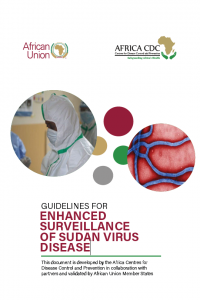
Guidelines for Enhanced Surveillance of Sudan Virus Disease
Description
Transmission SUDV spreads through direct contact with blood, tissues, and body fluids (e.g., saliva, sweat, tears, mucus, vomit, faeces, breast milk, urine, and semen) of infected humans or animals. The virus can persist in certain areas of the body (e.g., eyes and placenta) and within fluids (e.g., semen and cerebrospinal fluid) after recovery from the illness for a prolonged period of time (e.g., up to five years). A person cannot transmit the virus during the incubation period.Case definitions The World Health Organization (WHO) developed standard case definitions to facilitate the detection and reporting of suspected, probable, confirmed cases, deaths, and contacts of Ebola virus disease (EVD), which includes SVD8. Countries are recommended to adopt these definitions to their local contexts. In addition, in countries where there is an active ongoing outbreak like Uganda, community case definitions should be developed in addition to those used by mobile health teams and health facilities.
